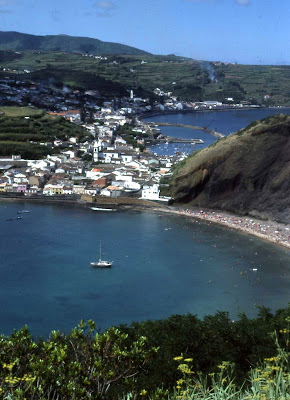The Azores, volcanic in origin, with impressive cliffs and
mountain peaks, are thought by some people to be the remains of the legendary
continent of Atlantis. While that may
be rather far fetched, the islands do seem to be a bit of paradise stuck out
there in the middle of nowhere. The
archipelago consists of nine islands scattered over a distance of 375 miles
from Corvo to Santa Maria.
Horta, the main town on the island of Faial, is the only decent, safe port in the whole archipelago and is, therefore, the meeting place for yachts on the west-to-east Atlantic crossing. We were told that, the year before, in 1983, 600 yachts had visited the Azores.
 |
| The harbor at Horta where we anchored. |
Horta, the main town on the island of Faial, is the only decent, safe port in the whole archipelago and is, therefore, the meeting place for yachts on the west-to-east Atlantic crossing. We were told that, the year before, in 1983, 600 yachts had visited the Azores.
More temperate than tropical, the islands are given over to
agriculture. Viewed from a distance,
the hillsides appear to be patchwork quilts of cultivated fields. During our wanderings on foot, we discovered
that windbreaks planted with sugar cane form the distinctive outlines of the
fields. The flowers of the Azores
seemed more subdued than Bermuda's.
Rather than riots of color, we found the cool purples, blues and whites
of hydrangeas blooming in profusion.
Fruits and vegetables are grown on the islands. We feasted on fresh pineapple, yellow plums, large purple grapes, small, thin bananas, and tomatoes, onions, carrots, potatoes, cucumbers and cabbage. Cheese, locally produced, sold in small or large wheels, and the fresh bread and rolls from the bakery, were special treats.
 |
| The anchorage is visible in the background. |
Fruits and vegetables are grown on the islands. We feasted on fresh pineapple, yellow plums, large purple grapes, small, thin bananas, and tomatoes, onions, carrots, potatoes, cucumbers and cabbage. Cheese, locally produced, sold in small or large wheels, and the fresh bread and rolls from the bakery, were special treats.
The Azores belong to Portugal, and the "coin of the
realm" was the escudo. Yachties,
always concerned about money, walk around in shock their first couple days in
Horta, exclaiming over how unbelievably cheap everything was. We found a typical restaurant meal - rolls
with butter and cheese, meat or fish with potatoes and rice, sliced tomatoes, a
bottle of wine or a couple beers, dessert and tip - to run to about $6.00 for
the two of us. The moorings were free,
on a first come, first served basis; it cost us all of 80 cents to clear
Customs.
After our stay of nine months in Nantucket, we were
rather well seeped in the lore of the old whaling town, and life aboard the
whaling ships. In Nantucket, whaling
was viewed from an historical vantage point, but in the Azores, whaling was
still an active lifestyle. Many mornings
we popped our heads out of the hatch to see the whaling longboat (sails and
oars, no motor), and its crew being towed out of the harbor - meaning that
whales had been spotted offshore. In
the Azores they generally captured about 60 whales a year. The whales were processed on the island of
Pico, a near neighbor to Faial.
Fortunately, with increased environmental awareness, the islanders had
decided to give up whaling. The last
whale was taken during our visit in 1984. |
| The whaling boat, being towed out of the harbor. Hard to believe such a small boat was used to capture a whale. |




No comments:
Post a Comment